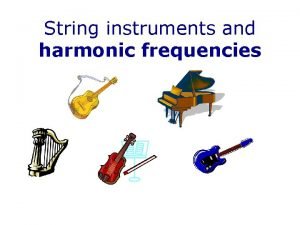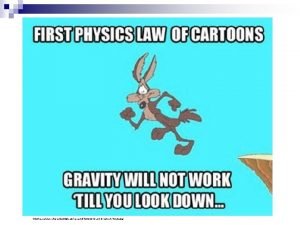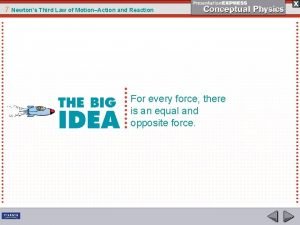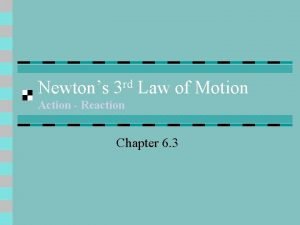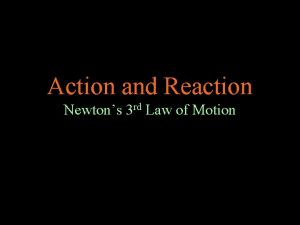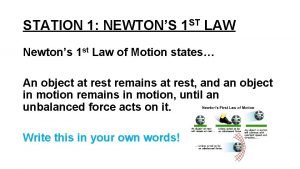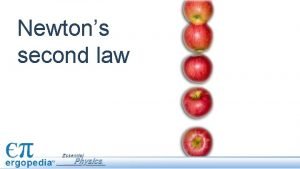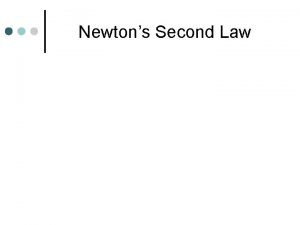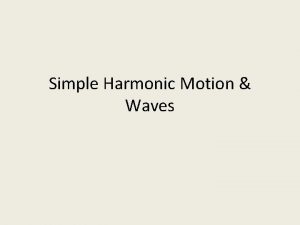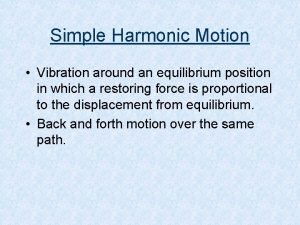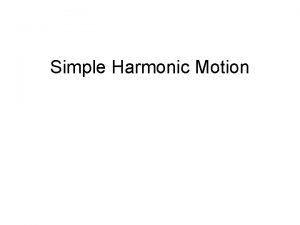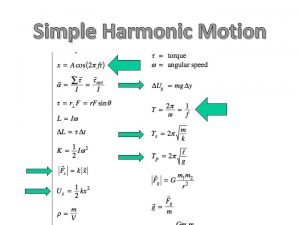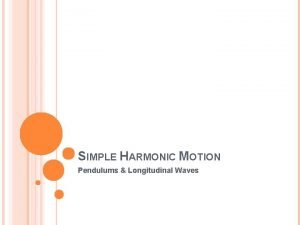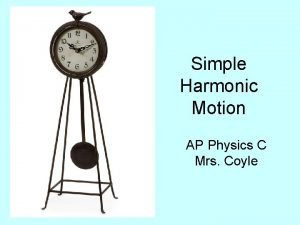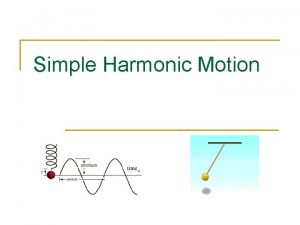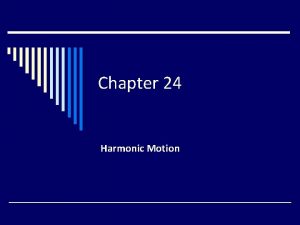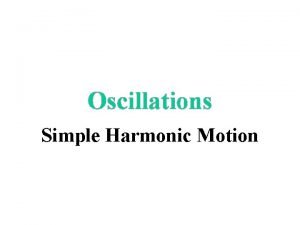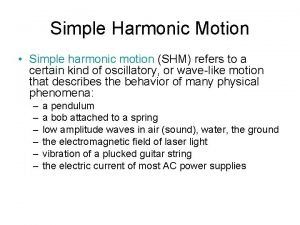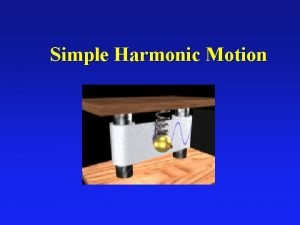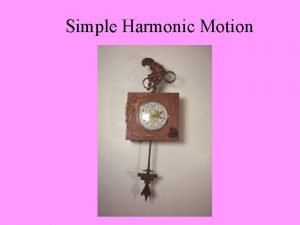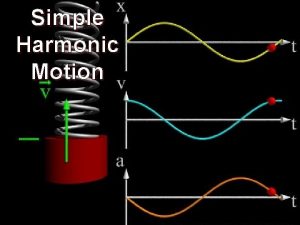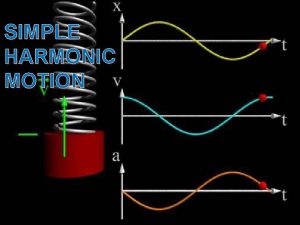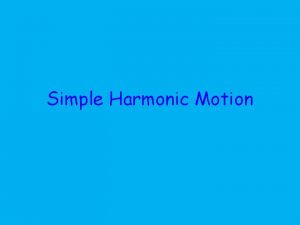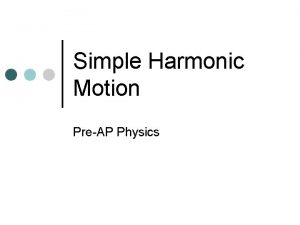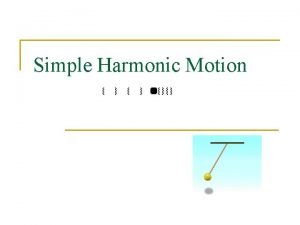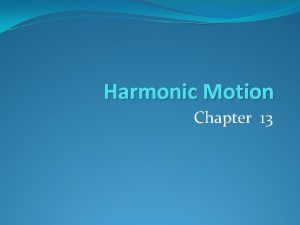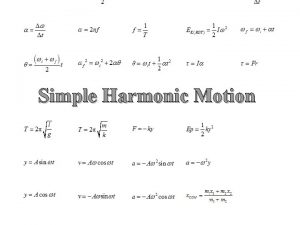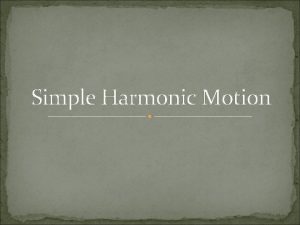SIMPLE HARMONIC MOTION NEWTONS LAW simple not simple







![REVIEW PENDULUM q L T m mg Re[C], Im[C] chosen to fit initial conditions. REVIEW PENDULUM q L T m mg Re[C], Im[C] chosen to fit initial conditions.](https://slidetodoc.com/presentation_image/451a3c9878cf005d264631e94528df85/image-8.jpg)













- Slides: 21

SIMPLE HARMONIC MOTION: NEWTON’S LAW simple not simple PRIOR READING: Main 1. 1, 2. 1 Taylor 5. 1, 5. 2 0 http: //www. myoops. org/twocw/mit/NR/rdonlyres/Physics/8 -012 Fall-2005/7 CCE 46 AC-405 D-4652 -A 724 -64 F 831 E 70388/0/chp_physi_pndulm. jpg

The simple pendulum Energy approach q T m mg 1

The simple pendulum Energy approach q T m mg 2

The simple pendulum q T m Newton Known torque mg This is NOT a restoring force proportional to displacement (Hooke’s law motion) in general, but IF we consider small motion, IT IS! Expand the sin series … 3

q L The simple pendulum in the limit of small angular displacements T m mg What is (t) such that the above equation is obeyed? is a variable that describes position t is a parameter that describes time "dot" and "double dot" mean differentiate w. r. t. time g, L are known constants, determined by the system. 4

REVIEW PENDULUM q L T m mg C, p are unknown (for now) constants, possibly complex Substitute: p is now known (but C is not!). Note that w 0 is NOT a new quantity! It is just a rewriting of old ones - partly 5 shorthand, but also "w" means "frequency" to physicists!

REVIEW PENDULUM q L T TWO possibilities …. general solution is the sum of the two and it must be real (all angles are real). m mg If we force C' = C* (complex conjugate of C), then x(t) is real, and there are only 2 constants, Re[C], and Im[C]. A second order DEQ can determine only 2 arbitrary constants. Simple harmonic motion 6
![REVIEW PENDULUM q L T m mg ReC ImC chosen to fit initial conditions REVIEW PENDULUM q L T m mg Re[C], Im[C] chosen to fit initial conditions.](https://slidetodoc.com/presentation_image/451a3c9878cf005d264631e94528df85/image-8.jpg)
REVIEW PENDULUM q L T m mg Re[C], Im[C] chosen to fit initial conditions. Example: q(0) = 0 rad and dqdt(0) = 0. 2 rad/sec 7

REVIEW PENDULUM q L T m mg 8

Remember, all these are equivalent forms. All of them have a known w 0=(g/L)1/2, and all have 2 more undetermined constants that we find … how? Do you remember how the A, B, C, D constants are related? If not, go back and review until it becomes second nature! 9

q L T The simple pendulum ("simple" here means a point mass; your lab deals with a plane pendulum) m mg simple harmonic motion ( potential confusion!! A “simple” pendulum does not always execute “simple harmonic motion”; it does so only in the limit of small amplitude. ) Period does not depend on qmax, f 10

Free, undamped oscillators – other examples k m L No friction k m I C q x Common notation for all T m mg

• The following slides simply repeat the previous discussion, but now for a mass on a spring, and for a series LC circuit 12

REVIEW MASS ON IDEAL SPRING Newton k k m Particular type of force. m, k known m x Linear, 2 nd order differential equation What is x(t) such that the above equation is obeyed? x is a variable that describes position t is a parameter that describes time "dot" and "double dot" mean differentiate w. r. t. time m, k are known constants 13

REVIEW MASS ON IDEAL SPRING k k m m x C, p are unknown (for now) constants, possibly complex Substitute: p is now known. Note that w 0 is NOT a new quantity! It is just a rewriting of old ones - partly shorthand, but also “w” 14 means “frequency” to physicists!

k k m A, f chosen to fit initial conditions: x(0) = x 0 and v(0) = v 0 m x Square and add: Divide: 15

2 arbitrary constants (A, f) because 2 nd order linear differential equation 16

Position: • A, f are unknown constants - must be determined from initial conditions • w 0, in principle, is known and is a characteristic of the physical system Velocity: Acceleration: This type of pure sinusoidal motion with a single frequency is called SIMPLE HARMONIC MOTION 17

THE LC CIRCUIT DIFFERENTIAL EQUATION L I C q Kirchoff’s law (not Newton this time) Same differential equation as the SHO spring!

What is inductance? ? It is how much magnetic flux is created in the inductor coil by a given current I, in a wire. What is the voltage change across an inductor? A voltage change occurs WHEN there is change in magnetic flux (i. e. some of the energy is ‘converted’ to a magnetic field) 19

THE LC CIRCUIT Kirchoff’s law (not Newton this time) L I C q
 What is the formula of simple harmonic motion
What is the formula of simple harmonic motion Wave
Wave Newtons 3 rd law of motion
Newtons 3 rd law of motion Newtons 3 rd law of motion
Newtons 3 rd law of motion Newton's third law
Newton's third law Rd law
Rd law Newton's 1st law meme
Newton's 1st law meme Newton's 3 laws of motion
Newton's 3 laws of motion Newton's third law
Newton's third law Newtons 3 rd law of motion
Newtons 3 rd law of motion What are newton's 3 laws
What are newton's 3 laws Newtons 3 rd law of motion
Newtons 3 rd law of motion Newton 1st law of motion
Newton 1st law of motion What's newtons second law of motion
What's newtons second law of motion What is newtons second law
What is newtons second law Brainpop newton's laws of motion worksheet answer key
Brainpop newton's laws of motion worksheet answer key Simple harmonic motion vocabulary
Simple harmonic motion vocabulary Simple harmonic motion equilibrium position
Simple harmonic motion equilibrium position Simple harmonic motion springs
Simple harmonic motion springs Reference circle simple harmonic motion
Reference circle simple harmonic motion What unit is period measured in
What unit is period measured in Harmonic motion equation
Harmonic motion equation

